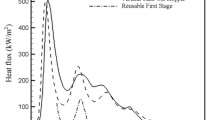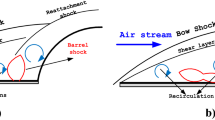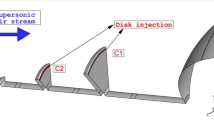Abstract
Validated by the correlated experiments, a nose-tip with forward-facing cavity/opposing jet/the combinatorial configuration of forward-facing cavity and opposing jet thermal protection system (TPS) are investigated numerically. The physical mechanism of these TPS is discussed, and the cooling efficiency of them is compared. The combinatorial system is more suitable to be the TPS for the high speed vehicles which need fly under various flow conditions with long-range and long time.










Similar content being viewed by others

References
Zhang F, Liu WQ (2007) Analysis of thermal wrinkling resulted from non-uniform temperature distribution in transpiration cooling formed platelets. Acta Aeronaut et Astronaut Sinica 28(1):138 (in Chinese)
Ye H, Geng X (2011) The feasibility analysis of the application of TPV system in reentry. Sci China Tech Sci 41(1):102 (in Chinese)
Glass DE (2006) Heat-pipe-cooled leading edges for hypersonic vehicles. NASA Langley Research Center July 12–13
Hartmann J, Troll B (1922) On a new method for the generation of sound waves. Phys Rev 20(6):719
Engblom WA, Goldstein DB (1997) Fluid dynamics of hypersonic forward-facing cavity flow. J Spacecr Rocket 34(4):437
Rifki R, Ahmed A (2009) Flowfield of a forward-facing shaped-charge cavity. J Aircraft 46(3):1059
Burbank PB, Stallings RL (1959) Heat-transfer and pressure measurements on a flat nose cylinder at a mach number range of 2.49 to 4.44. NASA TM X-221
Yuceil B, Dolling DS, Wilson D (1993) A preliminary investigation of the helmholtz resonator concept for heat flux reduction. AIAA 1993-2742
Engblom WA, Golsatein DB (1996) Nose-tip surface heat reduction mechanism. AIAA 96-0354
Seiler F, Srulijes J, Pastor MG, et al (2007) Heat fluxes inside a cavity placed at the nose of a projectile measured in a shock tunnel at mach 4.5. New Res. in Num. and Exp. Fluid Mech. VI, NNFM96:309
Saravanan S, Nagashetty K, Jagadeesh G, et al (2007) Experimental investigation of heat transfer reduction using forward facing cavity for missile shaped bodies flying at hypersonic speed. In: 26th international symposium on shock waves, part VIII: 316
Saravanan S, Jagadeesh G, Reddy KPJ (2009) Investigation of missile-shaped body with forward-facing cavity at mach 8. J Spacecr Rocket 46(3):577
Warren CHE (1960) An experimental investigation of the effect of ejecting a coolant gas at the nose of a bluff body. J Fluid Mech 8(3):400
Aso S, Hayashi K, Mizoguchi M (2002) A study on aerodynamic heating reduction due to opposing jet in hypersonic flow. AIAA 2002-0646
Hayashi K, Aso S (2003) Effect of pressure ratio on aerodynamic heating reduction due to opposing jet. AIAA 2003-4041
Hayashi K, Aso S, Tani Y (2005) Numerical study of thermal protection system by opposing jet. AIAA 2005-188
Tian T, Yan C (2008) Numerical simulation on opposing jet in hypersonic flow. J Beijing Univ Aero Astron 34(1):9 (in Chinese)
Tamada I, Aso S, Tani Y (2010) Reducing aerodynamic heating by the opposing jet in supersonic and hypersonic flows. AIAA 2010-991
Yan C (2006) Computational fluid dynamics methodology and application. Beijing University of Aeronautics and Astronautics Press, Beijing (in Chinese)
Tao WQ (2001) Numerical heat transfer, 2nd edn. Xi’an Jiaotong University Press, Xi’an (in Chinese)
Azevedo JLF, Heidi K (1998) Comparison of unstructured grid finite volume methods for cold gas hypersonic flow simulations. AIAA 98-2629
Wang CY (2000) Computational fluid dynamics and parallel algorithm. National University of Defense Technology Press, Changsha (in Chinese)
Baker AJ (1980) Numerical grid generation techques. NASA CP-2166
Middelcoff JF, Thomas PD (1979) Direct control of the grid point distribution in meshes generated by elliptic equations. AIAA 1979-1462
Chang KS, Choi CJ (1986) Separeted laminar natural convection above a horizontal isothermal square cylinder. Int Commun Heat Mass Transf 13(2):201
Acknowledgments
This work was supported by the Major Program of National Natural Science Foundation of China (Grant No. 90916018) and the Research Fund for the Doctoral Program of Higher Education of China (Grant No. 200899980006).
Author information
Authors and Affiliations
Corresponding author
Rights and permissions
About this article
Cite this article
Lu, HB., Liu, WQ. Research on thermal protection mechanism of forward-facing cavity and opposing jet combinatorial thermal protection system. Heat Mass Transfer 50, 449–456 (2014). https://doi.org/10.1007/s00231-013-1247-3
Received:
Accepted:
Published:
Issue Date:
DOI: https://doi.org/10.1007/s00231-013-1247-3



